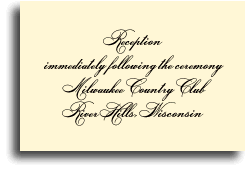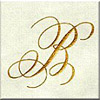The pieces of a Wedding Invitation Ensemble
A full wedding invitation enclosure consists of several pieces: the invitation and any of several enclosure cards. The minimal requirement is the invitation itself. Invitations are usually printed on heavy paper stock, which is folded once, or twice (French fold). It may also be printed on a single heavy card stock. Paper colors range from bright white to an ecru (ivory). A raised panel may border the face of the invitation. Traditionally, the lettering is in black, but a color or a metallic gold is not unusual.
Here is a description of the various pieces and their function:

Invitations: The composition of the invitation copy is dependent on your situation. Basically you need to know a few things like who is doing the inviting (usually the bride's parents), who are the participants (their full names and titles), the kind of ceremony (church, Nuptial Mass, or private), when, and where.
Invitations are enclosed into two envelopes: an inside and outside. The outside is for mailing and contains the full address of the person it is sent to. The inside is intended to be the presentation envelope and therefore contains only the addressee's name. It has no gumming. The best invitations are topped with a tissue to protect the engraved lettering from wear or damage. The envelopes and tissues are usually included in the price of the invitation.
Announcements (not shown): An announcement is sent to inform family and friends of a wedding where an invitation would be impracticable. They are sent after the ceremony. They look very similar to an invitation but contain different wording.

Reception Cards: The Reception Card is a subsidiary invitation to a subsequent but separate event: the Reception. If the Reception is held at a different location than the wedding a separate card is required. If the wedding ceremony and reception are held together at the same location, then one may include the invitation to the reception on the larger invitation. Reception cards may include RSVP requests in the bottom corner.

Reply Cards & Return Envelopes: Reply cards have now gained wide acceptance and therefore have become proper wedding etiquette. They consist of the card with blanks for filling in of one's name and response, and the return envelope with the name and address of the person receiving the response engraved on the front.

At Home Cards: Since most married couples start life anew at a new home, your family and friends can be informed of your new address with an At Home card. On it is the date of your arrival (after the honeymoon), the street address, and phone number if desired. One may now also include an e-mail address, but be careful. Since the card should match the style of the invitation, the e-mail may not look readable in the type style you are using.
Direction Cards (not shown): These are used when the location of the ceremony or reception is not widely known or you expect many out-of-town guests. Explicit directions from several starting points are given. One may also enclose a simple map.
Accommodation Cards (not shown): If you have many out-of-town guests who need to make hotel arrangements you would use an accommodation card. It lists the name of two or three convenient hotels with their phone numbers. If the host has reserved and paid for a room for a guest, this would be stated also.
Ceremony, Reception and Post-Wedding items

Thank You Notes (Informals): After the wedding the bride should send a personal thank you note which not only expresses your appreciation but acknowledges the receipt of gifts. This is done on a small single top-fold notepaper with an engraved name(s) or monogram design on the front. The handwritten message is penned inside the opened fold. In the past only the bride's name or monogram was used, but it is now more common to use the "Mr. and Mrs." form. There is still some debate whether this form is acceptable, so use some judgement when choosing.

Table Cards: At the reception this card has a envelope with the guest's name and a card with a table number inscribed. They are displayed at the reception entryway where your guest will pick them up.
Napkins (not shown): Although outside the realm of etiquette, people do enjoy the use of special occasion napkins with the couple's names and the date printed on the corner. Most napkins are available in a variety of colors and motif designs, and are quite inexpensive.
Ceremony Programs (not shown): Some people prefer a finely printed program that matches the style of your invitation rather than the plainer program provided by most churches. The program booklet includes a title page, a Wedding Party list, the Order of Service, and special notes and thanks. It can have an embossed or engraved monogram stamped on the heavy stock front cover.
Place Cards (not shown): A stand-up small folding card, these are placed at each setting to guide the guests to their seats.
Menu Cards (not shown): They detail the courses that will be served. One card may be shared by two guest and is placed between two settings.
Save The Date Card (not shown): A relatively newcomer in wedding etiquette. Some out-of-town guests and those with inflexible schedules may require advanced notice of your wedding date in order to make travel plans. A must during busy summer and holiday seasons.


